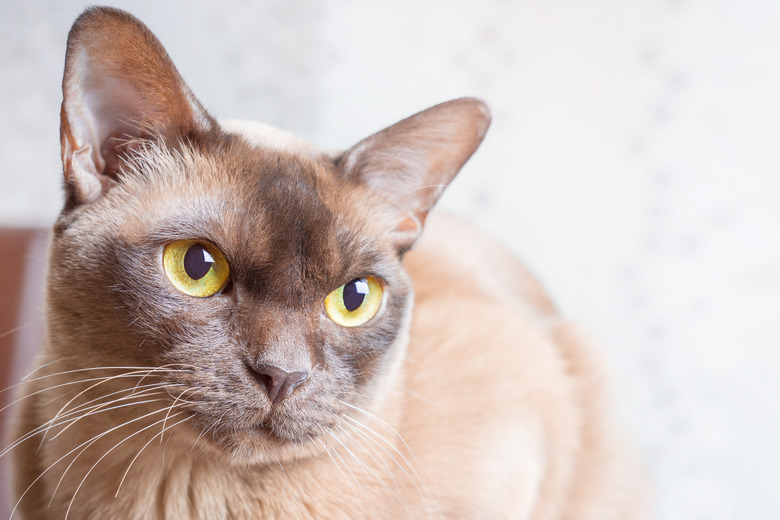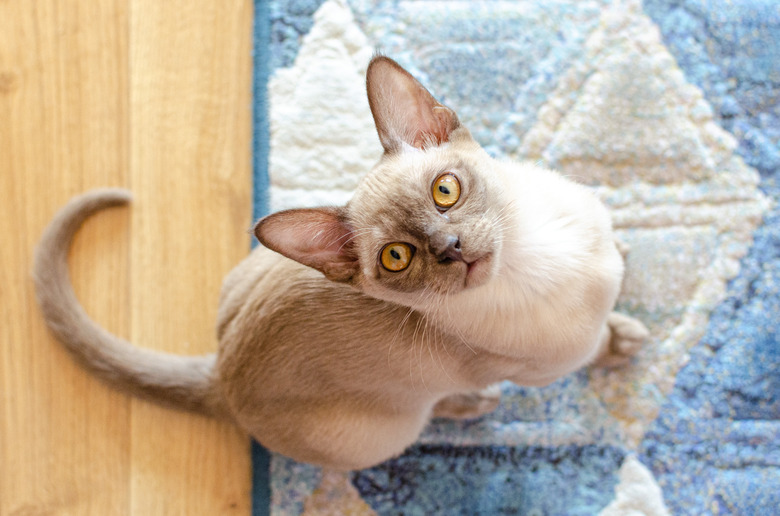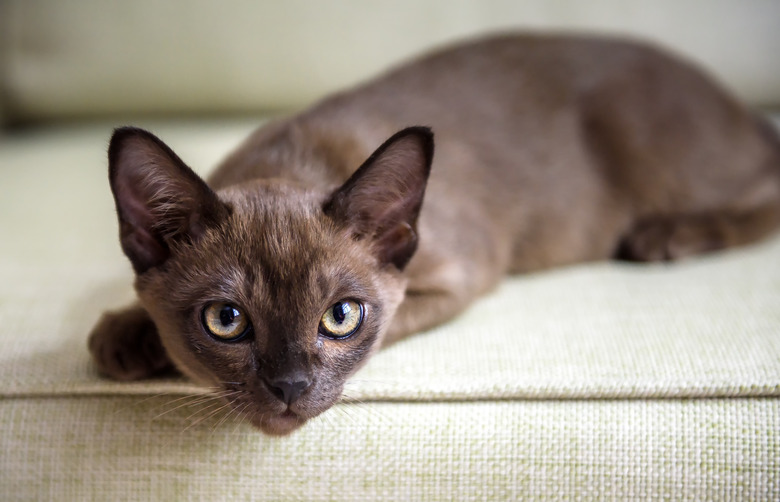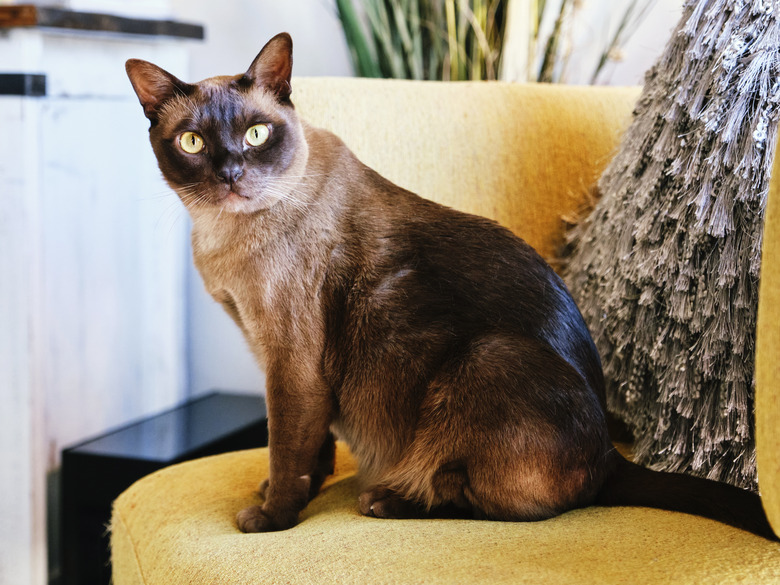Burmese Cat Breed Characteristics
Burmese cat quick facts
Burmese cat quick facts
Length: 12 – 16 inches
Weight: 8 – 12 pounds, males tend to be larger than females
Lifespan: 12 – 16 years
Coat length: Short
Coloring: Sable, champaign, blue, or platinum with yellow or gold eyes
Grooming needs: Low
Friendliness: Breed alone is not an accurate predictor of individual cats' personalities. However, Burmese cats are generally regarded as friendly, people-oriented cats.
Burmese cats are arguably one of the best family cats around. They love people and enjoy the attention. They also do well even in households with children. They have a unique appearance with a compact body structure. Their short muzzle gives them a distinctive profile. Before bringing a purebred Burmese into your home, consider their personality and care needs to make sure it is a good match — both for you and your new cat.
Burmese cat history
Burmese cat history
The Burmese cat breed originated in Burma near the Thailand border. A dark brown cat named Wong Mau was brought to San Francisco and given to Dr. Joseph Thompson. When Dr. Thompson first saw the cat, he did not believe her to be a Siamese cat as many of his colleagues did. He then started a breeding program, where Wong Mau became the first cat bred to a seal point Siamese male named Tai Mau.
Through the breeding program, Burmese breeders sought to bring out the traits that define the modern Burmese breed today. This included a medium-sized, compact body, rounded, wide-set eyes, and a short muzzle. Originally, all cats in the breed were sable in color. However, other colors emerged and were accepted by different breed registries over time.
Breeders in Great Britain also contributed to the development of the breed and it was there that the first blue Burmese kitten was produced. The Cat Fanciers' Association (CFA) only recognizes four coat colors: blue, champaign, platinum, and sable. The International Cat Association (TICA), on the other hand, recognizes a wider range of solid and tortoiseshell pattern colors including lilac and chocolate.
Burmese cat personality
Burmese cat personality
The Burmese cat breed loves people. If you are looking for a cat that will truly be a loving part of the family, look no further. Burmese cats get along with children of all ages. These sociable cats frequently speak with a soft meow and are true lap cats who enjoy cuddling with any member of the family.
The breed is very intelligent and they even have some dog-like traits in that they enjoy playing fetch. They can readily learn tricks from attentive family members. Burmese cats need plenty of attention. While they don't tend to be demanding, they may not be an ideal choice for a single person who works long hours.
Burmese cat lifespan & health issues
Burmese cat lifespan & health issues
This breed tends to have few health problems and generally lives 12 years or more. The breed is at risk for hypertrophic cardiomyopathy, a type of heart disease. Responsible breeders should screen their cats for the disease regularly. The test for the condition is a heart ultrasound. Therefore it may not catch the disease in the cat's early years of life.
Some other health conditions that may affect the breed include diabetes mellitus and hypokalaemic polymyopathy, or low potassium levels that cause muscle weakness. In addition, some American Burmese kittens suffer from deformities of the brain and head.
Although it is not common, feline orofacial pain syndrome can affect the breed. Cats with this condition lick and chew to express their discomfort. They may also rub or paw at their face. However, the pain is not constant. It is a neurological condition in which the nerves that communicate pain to the brain start misfiring.
Burmese cat grooming & care
Burmese cat grooming & care
The Burmese cat is a shorthair breed that needs very little grooming. Use a rubber brush about once per week to remove loose fur. Rub a soft cloth over their short coat to bring out the shine. As with all cats, be sure to check and trim their nails regularly and provide a cat tree and scratching post. Check and clean the cat's ears regularly and brush their teeth with toothpaste approved for use on pets.
Feed the cat high-quality cat food as recommended by your veterinarian and provide fresh drinking water throughout the day. Be sure to clean the litter box each day and change out the cat litter regularly. Burmese cats should be kept indoors — their fearless and friendly personality can get them into trouble if they are outdoor cats.
Welcoming a new cat into your home
Welcoming a new cat into your home
Burmese kittens are extremely playful. Adult cats tend to retain this quality, although the males tend to be more laidback than the female cats. In order to keep your new kitten safe, be sure to cat-proof the home. Set up a single room to introduce the cat to their new home. Make sure there is a litter box, food and water, toys, and a scratching post. Close off any potential hiding spots where the cat may get stuck or injured.
Allow your cat to explore their home at their own pace. Spend plenty of time in the room, but don't force them to be petted or held. Let them come to you when they are ready for play or affection. Always use positive reinforcement with your new cat. Positive reinforcement helps them learn faster and builds stronger relationships.
If you have other pets, make introductions through the door first. Ensure that all of the initial meetings are positive experiences for both pets. If you have children, teach them how to pet and hold the new cat. Make sure both the cat and the child are safe and happy in each other's company.
Once your cat is comfortable in the new space, you can give them the freedom to explore more of the house. For these people-loving cats, it shouldn't take long — they will surely want to follow you around.



